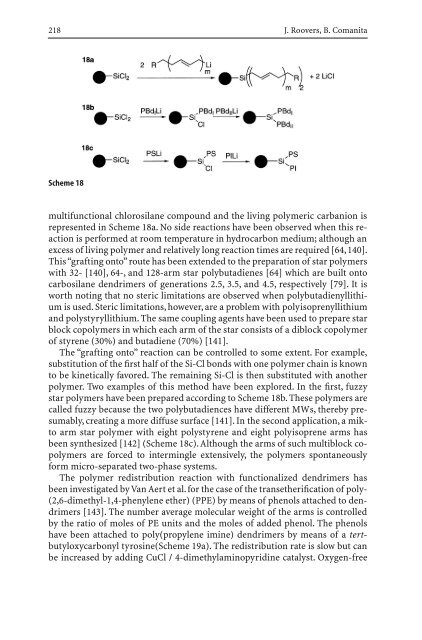142 Advances in Polymer Science Editorial Board: A. Abe. A.-C ...
142 Advances in Polymer Science Editorial Board: A. Abe. A.-C ...
142 Advances in Polymer Science Editorial Board: A. Abe. A.-C ...
Create successful ePaper yourself
Turn your PDF publications into a flip-book with our unique Google optimized e-Paper software.
218 J. Roovers, B. Comanita<br />
Scheme 18<br />
multifunctional chlorosilane compound and the liv<strong>in</strong>g polymeric carbanion is<br />
represented <strong>in</strong> Scheme 18a. No side reactions have been observed when this reaction<br />
is performed at room temperature <strong>in</strong> hydrocarbon medium; although an<br />
excess of liv<strong>in</strong>g polymer and relatively long reaction times are required [64, 140].<br />
This “graft<strong>in</strong>g onto” route has been extended to the preparation of star polymers<br />
with 32- [140], 64-, and 128-arm star polybutadienes [64] which are built onto<br />
carbosilane dendrimers of generations 2.5, 3.5, and 4.5, respectively [79]. It is<br />
worth not<strong>in</strong>g that no steric limitations are observed when polybutadienyllithium<br />
is used. Steric limitations, however, are a problem with polyisoprenyllithium<br />
and polystyryllithium. The same coupl<strong>in</strong>g agents have been used to prepare star<br />
block copolymers <strong>in</strong> which each arm of the star consists of a diblock copolymer<br />
of styrene (30%) and butadiene (70%) [141].<br />
The “graft<strong>in</strong>g onto” reaction can be controlled to some extent. For example,<br />
substitution of the first half of the Si-Cl bonds with one polymer cha<strong>in</strong> is known<br />
to be k<strong>in</strong>etically favored. The rema<strong>in</strong><strong>in</strong>g Si-Cl is then substituted with another<br />
polymer. Two examples of this method have been explored. In the first, fuzzy<br />
star polymers have been prepared accord<strong>in</strong>g to Scheme 18b. These polymers are<br />
called fuzzy because the two polybutadiences have different MWs, thereby presumably,<br />
creat<strong>in</strong>g a more diffuse surface [141]. In the second application, a mikto<br />
arm star polymer with eight polystyrene and eight polyisoprene arms has<br />
been synthesized [<strong>142</strong>] (Scheme 18c). Although the arms of such multiblock copolymers<br />
are forced to <strong>in</strong>term<strong>in</strong>gle extensively, the polymers spontaneously<br />
form micro-separated two-phase systems.<br />
The polymer redistribution reaction with functionalized dendrimers has<br />
been <strong>in</strong>vestigated by Van Aert et al. for the case of the transetherification of poly-<br />
(2,6-dimethyl-1,4-phenylene ether) (PPE) by means of phenols attached to dendrimers<br />
[143]. The number average molecular weight of the arms is controlled<br />
by the ratio of moles of PE units and the moles of added phenol. The phenols<br />
have been attached to poly(propylene im<strong>in</strong>e) dendrimers by means of a tertbutyloxycarbonyl<br />
tyros<strong>in</strong>e(Scheme 19a). The redistribution rate is slow but can<br />
be <strong>in</strong>creased by add<strong>in</strong>g CuCl / 4-dimethylam<strong>in</strong>opyrid<strong>in</strong>e catalyst. Oxygen-free
















